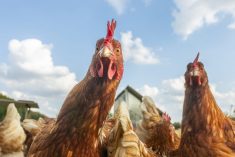So far as it can be measured with the slim data available, damage to Ontario farmers’ crops and livestock caused by wildlife has risen substantially in the last 10 years, a new study warns.
The costs of such damages rose between 1998 and a later study period from 2005 through 2007, by almost 20 per cent to $40.92 million, according to a new report prepared by the George Morris Centre for the Ontario Soil and Crop Improvement Association (OSCIA).
The centre’s report was meant as an update on a OSCIA survey done in 2000, “based on more recent conditions,” Al Mussel, a senior researcher with the Guelph-based ag think tank, said in a release Wednesday.
Read Also

U.S. livestock: Cattle strength continues
Cattle futures on the Chicago Mercantile Exchange were stronger on Friday, hitting fresh highs to end the week.
“Our results showed that wildlife damage costs had increased by about 20 per cent since 1998, even with the exclusion of effects from new wildlife species, and with a very compact list of field and horticultural crops impacted. We can quantify losses of about $41 million per year, but the true value of wildlife damage is apt to be significantly higher.”
In their new report, researchers Mussel and Claudia Schmidt recommend that systems be put in place to run surveys that compile these costs on a regular basis, so they can be updated from year to year.
“This would serve to identify the actual volume of wildlife damage, to evaluate the effects of prevention measures and to assess the costs incurred through wildlife damage to evaluate compensation schemes to farmers,” they wrote.
“Responsibility for such an activity should be shared by farm organizations, wildlife conservation groups and government.”
“Probably conservative”
By its nature, wildlife inventory is difficult to obtain, but the indication from secondary sources, in terms of expenditure on wildlife claims and wildlife harvest levels, suggest that the wildlife damage issue is “increasing, perhaps markedly,” Mussel and Schmidt wrote.
“Moreover, while most of the major Ontario crops are considered here, there is a range of minor crops not considered, which collectively could increase wildlife damage estimates significantly.
“Finally, there are new wildlife populations such wild turkey, elk, and sandhill cranes that damage farm products in the growing phase, which are not accounted for here. Thus, the loss rate from the 2000 study is probably conservative, which probably makes the 2005-07 results conservative.”
Comparing 1998 figures to the 2005-07 period, the report showed wildlife damage costs substantially up in wheat (up 93.5 per cent to $979,171), sheep (up 47 per cent to $730,505), grain corn (up 24.7 per cent to $17.2 million), hay and forage crops (up 27 per cent to $8.49 million), grapes (up 33.4 per cent to $2.44 million) and tender fruit (up 17 per cent to $2.33 million) among the commodities studied.
“Wildlife in Ontario is publicly held, and managed in trust for its citizens by the province,” Mussel and Schmidt wrote. “At the same time, throughout eastern, central, southern and southwestern Ontario, much of the wildlife habitat is provided by private landholders who are farmers. The provision of this wildlife habitat comes at a cost.”
Decreases in wildlife damage were seen in beef (down 18 per cent to about $828,812), apples (down 17.4 per cent to $1.64 million), blueberries (down 8.8 per cent to $157,326) and sweet corn (down 30.3 per cent to $151,329).
The OSCIA said it hopes the study’s results will encourage dialogue among policy makers. OSCIA president Murray Cochrane, a beef cattle producer from Thessalon, about 85 km east of Sault Ste. Marie, said it’s important to establish wildlife damage prevention measures and compensation packages for Ontario farmers.
“There are some good opportunities now available to producers that provide reasonable cost share for implementing measures to control problems,” Cochrane said.
“However, it is clear that more needs to be done to assist those who are experiencing significant and frequent crop and livestock losses attributed to wildlife. Meaningful solutions can surely be found if all parties agree to work together.”















